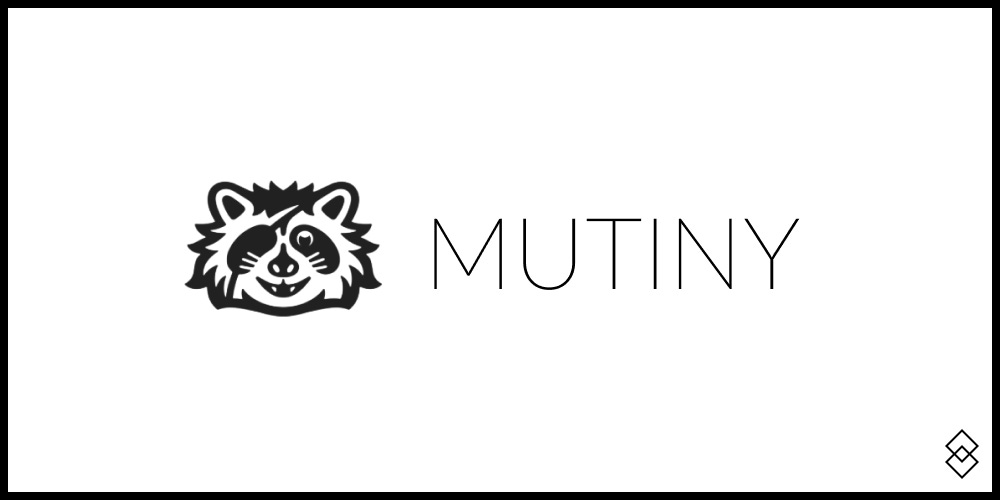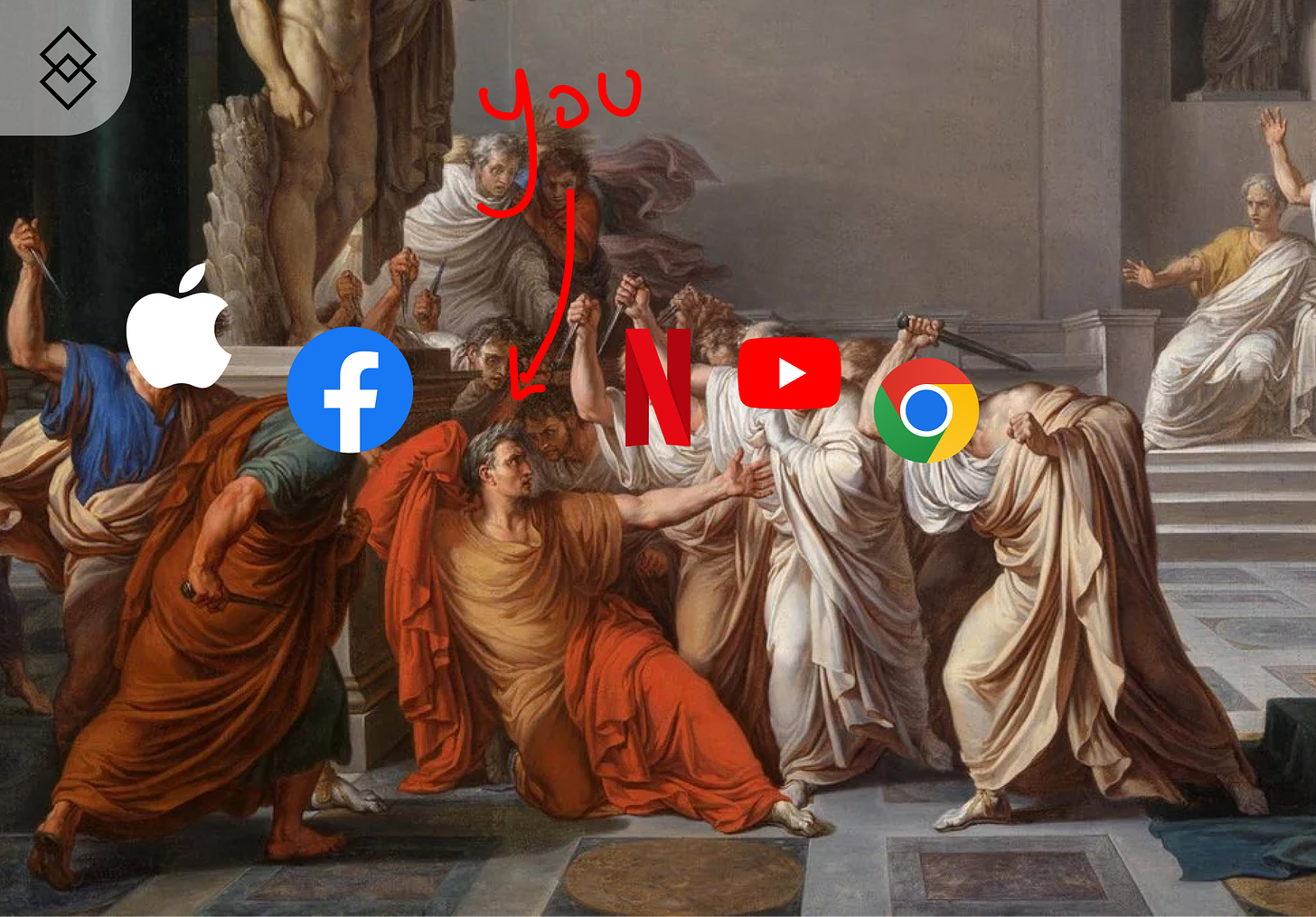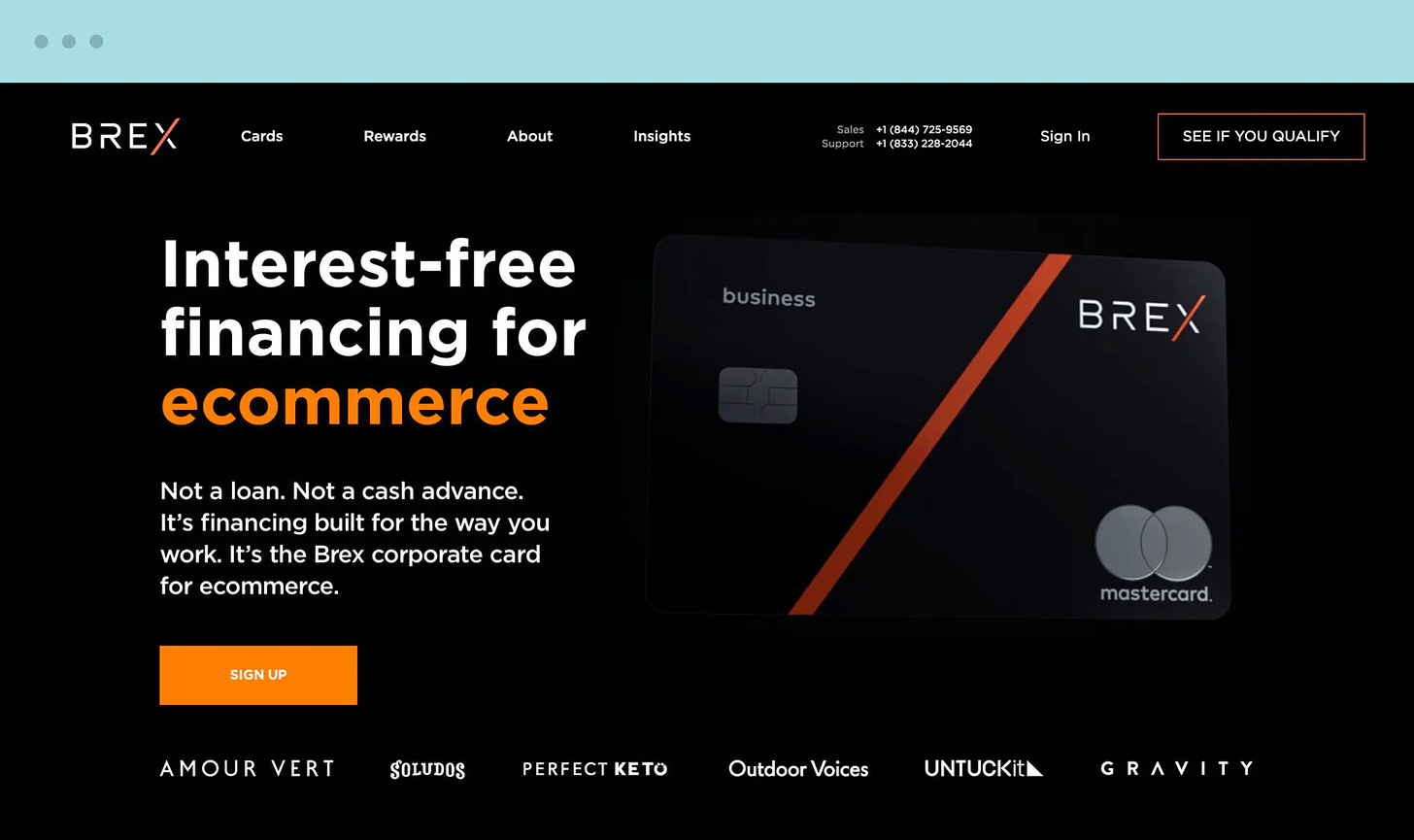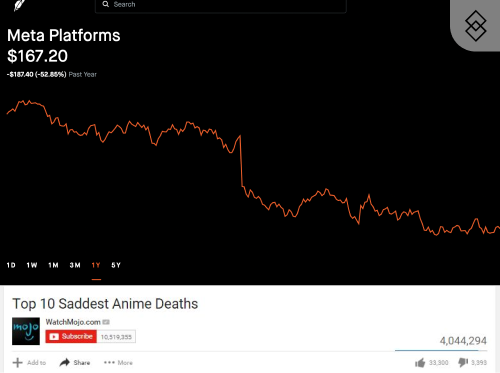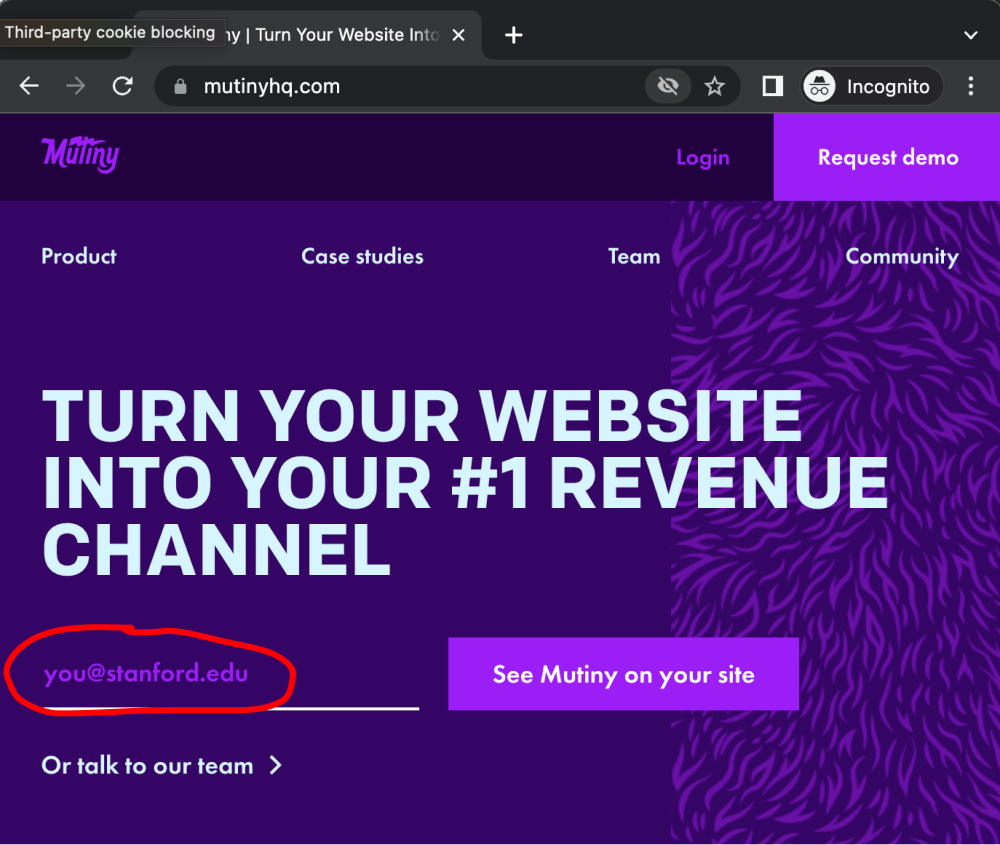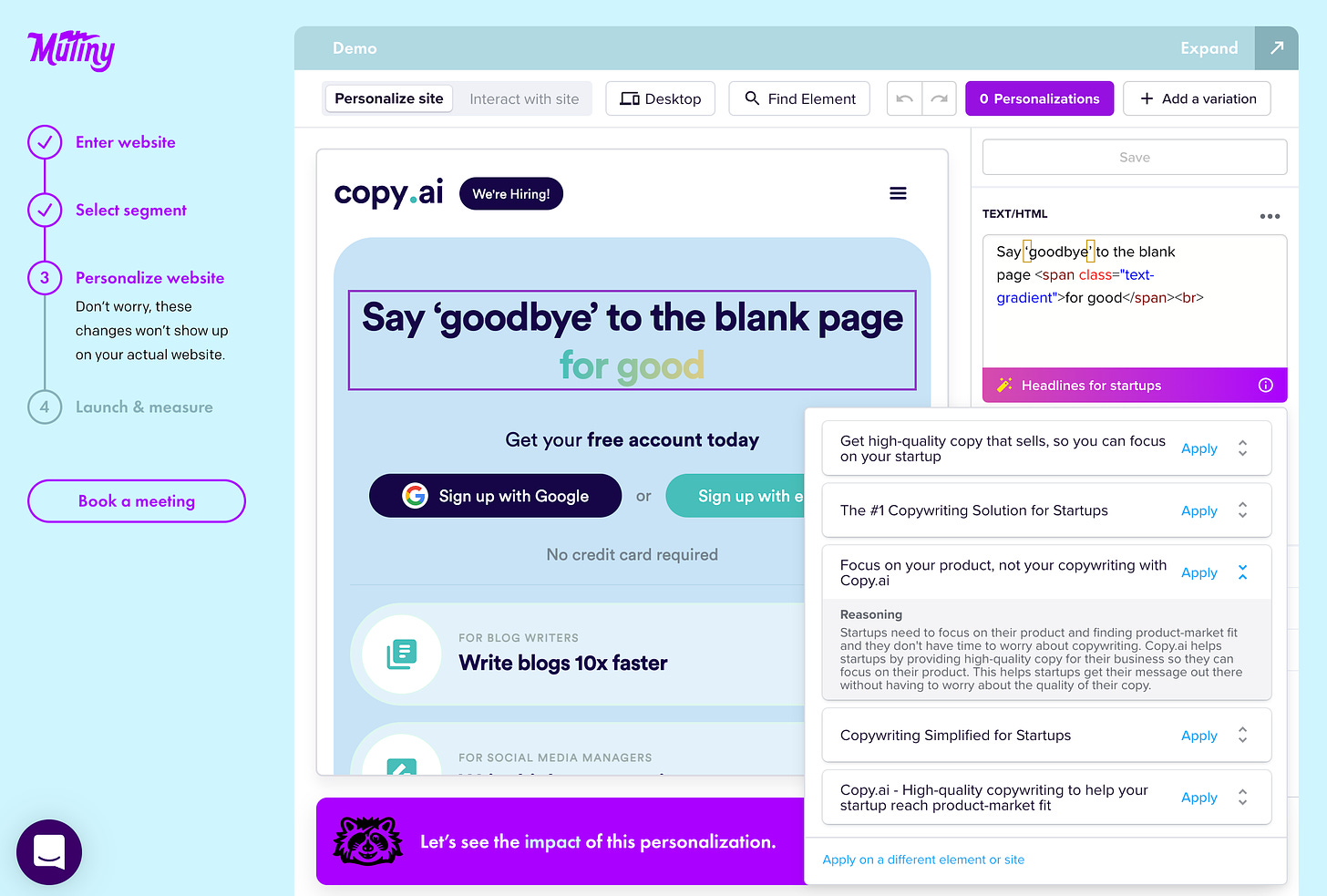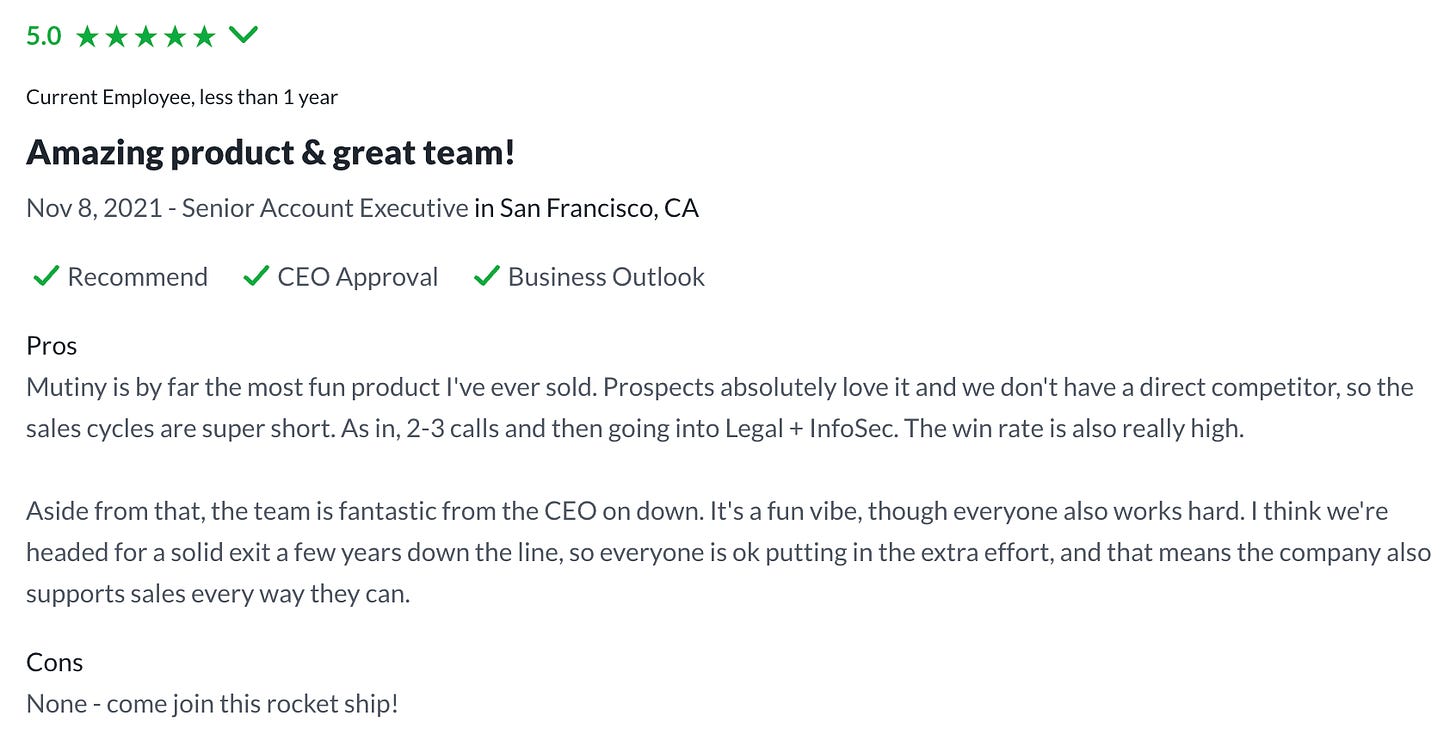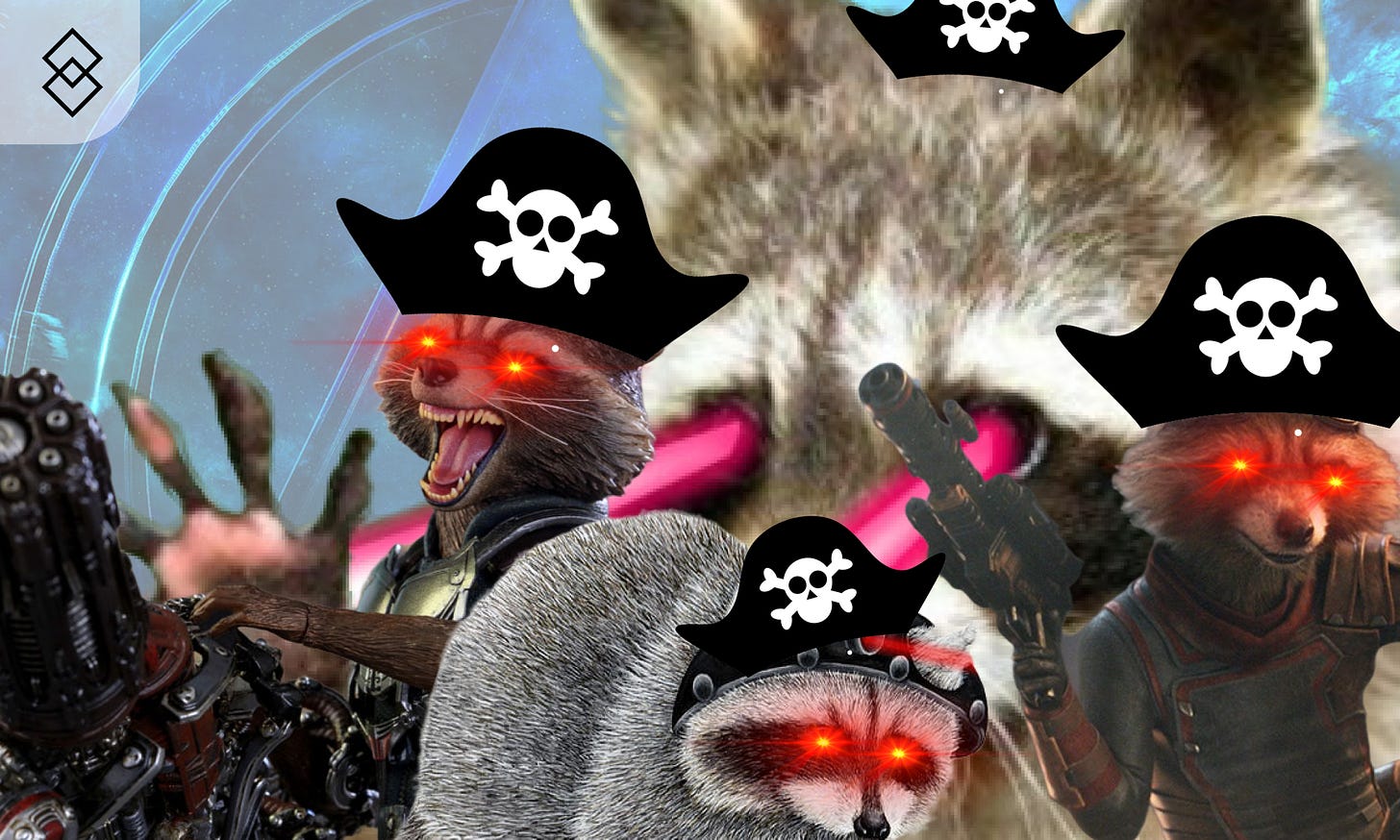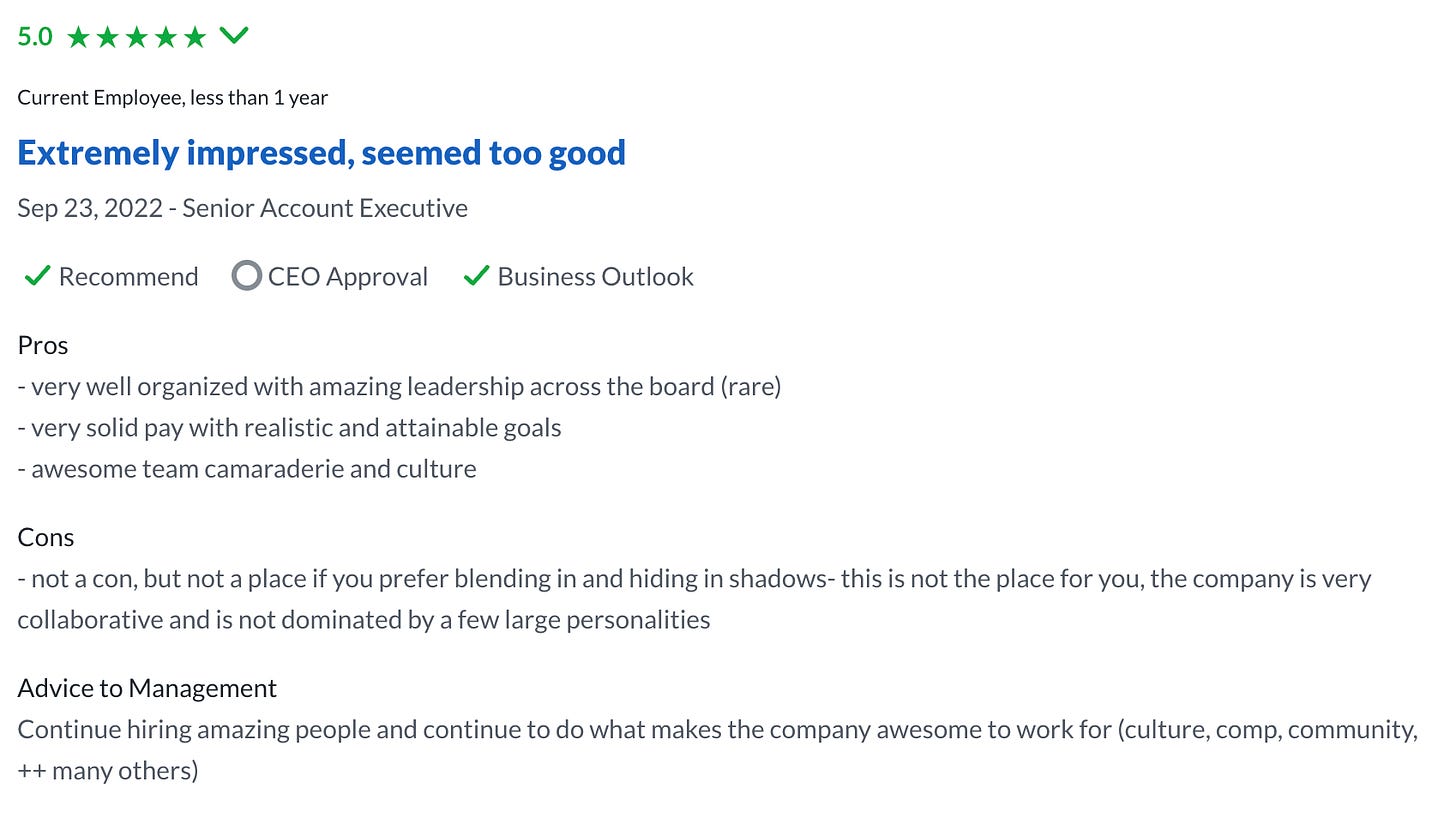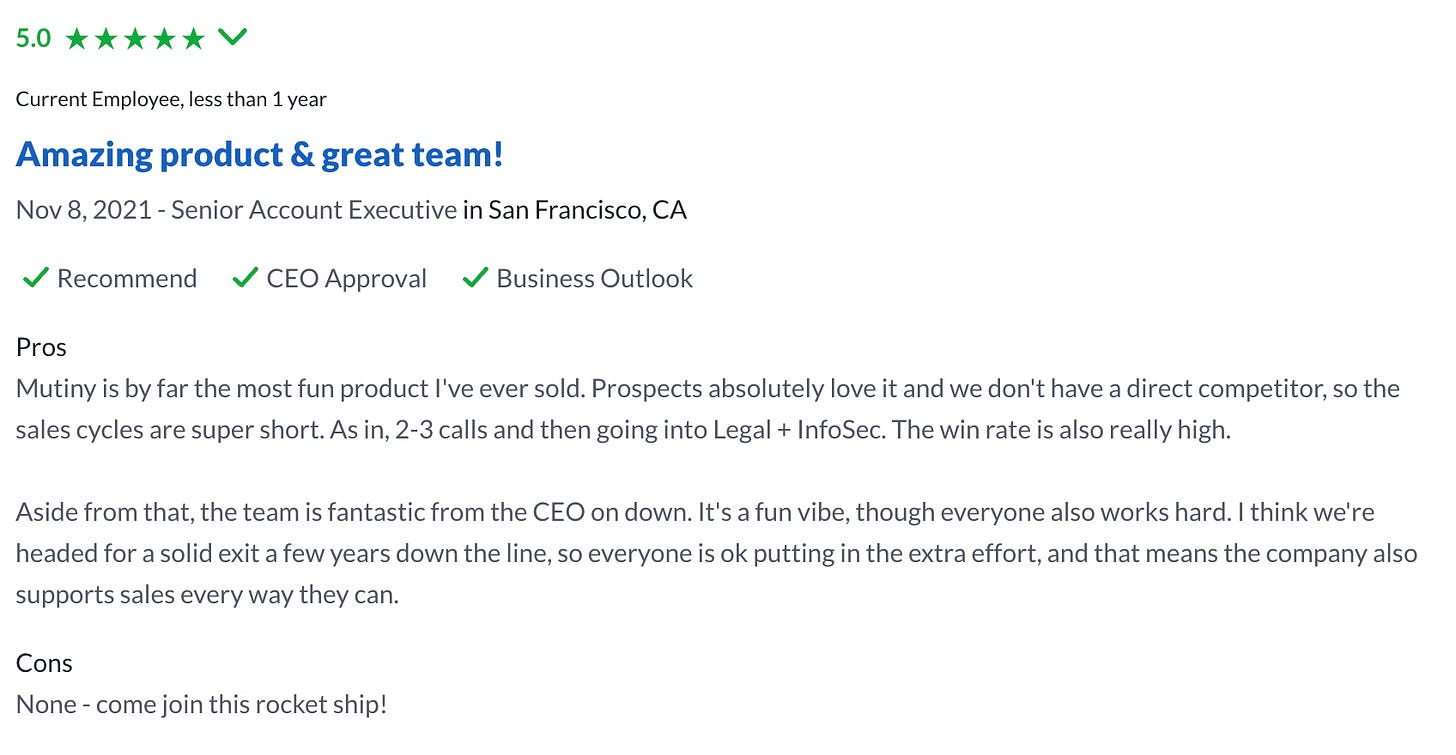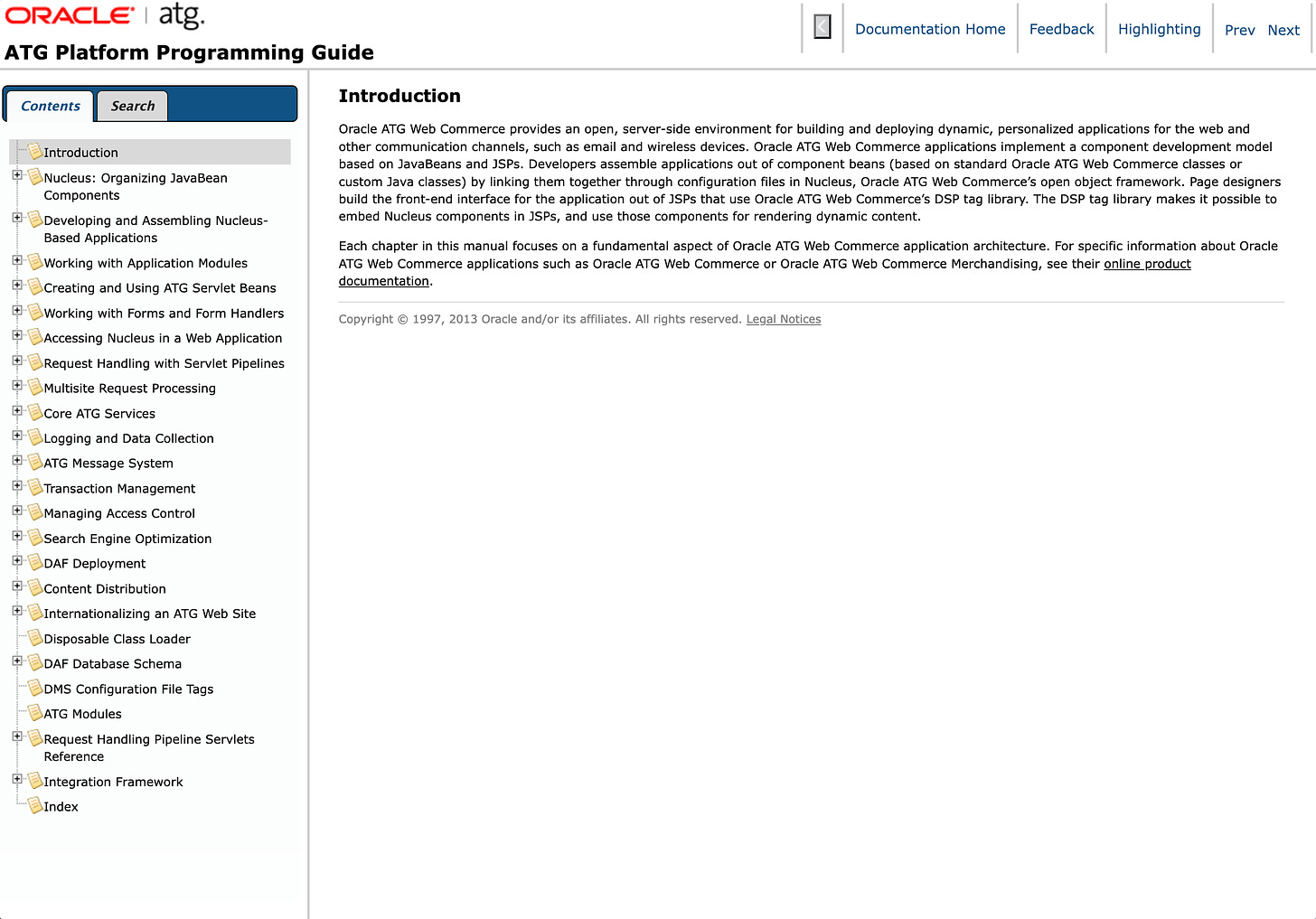Welcome to “Why You Should Join,” a monthly newsletter for engineers highlighting early-stage startups on track to becoming generational companies.
As engineers ourselves, we know how difficult it is to pick the right startup to join. Doing your own analysis for every TechCrunch article, recruiter InMail, or VC tweet would be impossible. Let us help you out instead :)
On the first Monday of each month, we we cut through the noise and use thorough research, rigorous analysis, and inside information we’ve hustled to get to present you with an early-stage startup we believe will become a generational company. We go deeper than any other source out there to help ambitious new grads, FAANG veterans, and experienced operators find the right rocket ship to join. Sound interesting? Join the family and subscribe here:
Why You Should Join Mutiny
(Click the link to read online).
It’s 2022, and the Adpocalypse is upon us. Youtube is sticking 5 un-skippable ads before videos. Chrome is removing support for ad-blockers. Netflix has announced an ad-supported subscription tier, and Uber has begun sticking ads for other companies in their own push notifications. Over the next four years, the world is projected to spend 3.7 trillion dollars on digital advertising.
Big tech has finally hit peak innovation. What a time to be alive.
It’s shocking, then, that 19 out of every 20 dollars spent on digital ads ends up totally wasted. Uber once cut ad spend by 120 million to find no change in app installs. Procter & Gamble once cut ad spend by 200 million to find no change in business outcomes. Despite the trillions poured into advertising technology over the past two decades, conversion rates are as terrible as ever.
Why? While ads have gotten increasingly personalized, their destinations haven’t. After clicking an ad, visitors usually land on generic websites that just don’t resonate. Even though a visitor might spend ten times as long on a website as they did the ad that brought them there, the site itself never ends up being as personalized. As a result, they leave before doing anything meaningful.
While most businesses end up buying more ads to compensate for this, the best companies have realized you can’t get around personalizing your website. Serving visitors a site designed specifically for them can reduce acquisition costs by 50%, lift revenues by 15 percent, and increase marketing efficiency by 30%. McKinsey considers it the “Holy Grail” of marketing for a reason.
Giving everyone access to cutting-edge personalization technology would unlock over a trillion dollars in value for the global economy while also dramatically reducing the amount of money we all waste on ads. It’s a tremendous shame that most companies can’t afford the expensive growth engineers and data scientists needed to do it themselves.
Thankfully, Mutiny’s changing that.
Background
If your company sells to schools, hospitals, and restaurants, it’s important that your website looks slightly different to each. While a school might expect to see testimonials from other schools on your home page, a hospital would expect to see testimonials from other hospitals.
Mutiny’s no-code platform lets you do this without hiring a bunch of growth engineers and data scientists. In the milliseconds it takes for a visitor to open your website, Mutiny automatically identifies that user and personalizes the site (changing headlines, swapping images, modifying call-to-action buttons, etc.) to help that user better understand your product or service.
Concretely, this creates value in two ways:
Higher Revenue
Personalizing your website makes it easier for a user to see why they should buy, increasing their chance of “converting” (booking a demo, registering for a trial, buying). In addition to boosting revenue by up to 15%, it can reduce acquisition costs by up to 50% and increase efficiency of marketing spend by 30%, all of which drive growth. For example, Mutiny helped Carta to increase seed stage signups by 80%, Livestorm to increase enterprise leads by 205%, and Brex to triple their signups.
Lower Overhead
Personalizing your website is slow and expensive since the infrastructure needed usually requires a team of engineers and data scientists to maintain. Mutiny’s end-to-end solution can be set up in minutes and requires no engineering talent to support. It’s a growth engineering team in a box.
How does it all work? Under the hood, Mutiny’s Javascript client begins by identifying anonymous website traffic using over 300 traits (i.e. size of company, industry/vertical, capital raised, persona/seniority, number of visits) drawn from pre-integrated datasources and a proprietary dataset developed by Mutiny itself. Then, based on who the visitor is, reinforcement learning algorithms personalize the site by replacing headlines, swapping images, adding popups, and inserting surveys. The personalized content might be original text from GPT-3, examples drawn from other Mutiny customers, or custom text your marketing team added themselves through Mutiny’s visual editor.
All of this happens within milliseconds of someone loading a site. It’s an impressive feat of engineering.
Mutiny launched publicly in October of 2019 and already counts some of the world’s fastest growing companies as clients. Customers include Dropbox, Snowflake, Ramp, Notion, Qualtrics, Carta, Brex, DocSend, Amplitude, and Segment. The company is on track to quadruple revenue in 2022, and estimates that roughly 100 million people across 4 million companies have seen a website personalized by their platform’s engine.
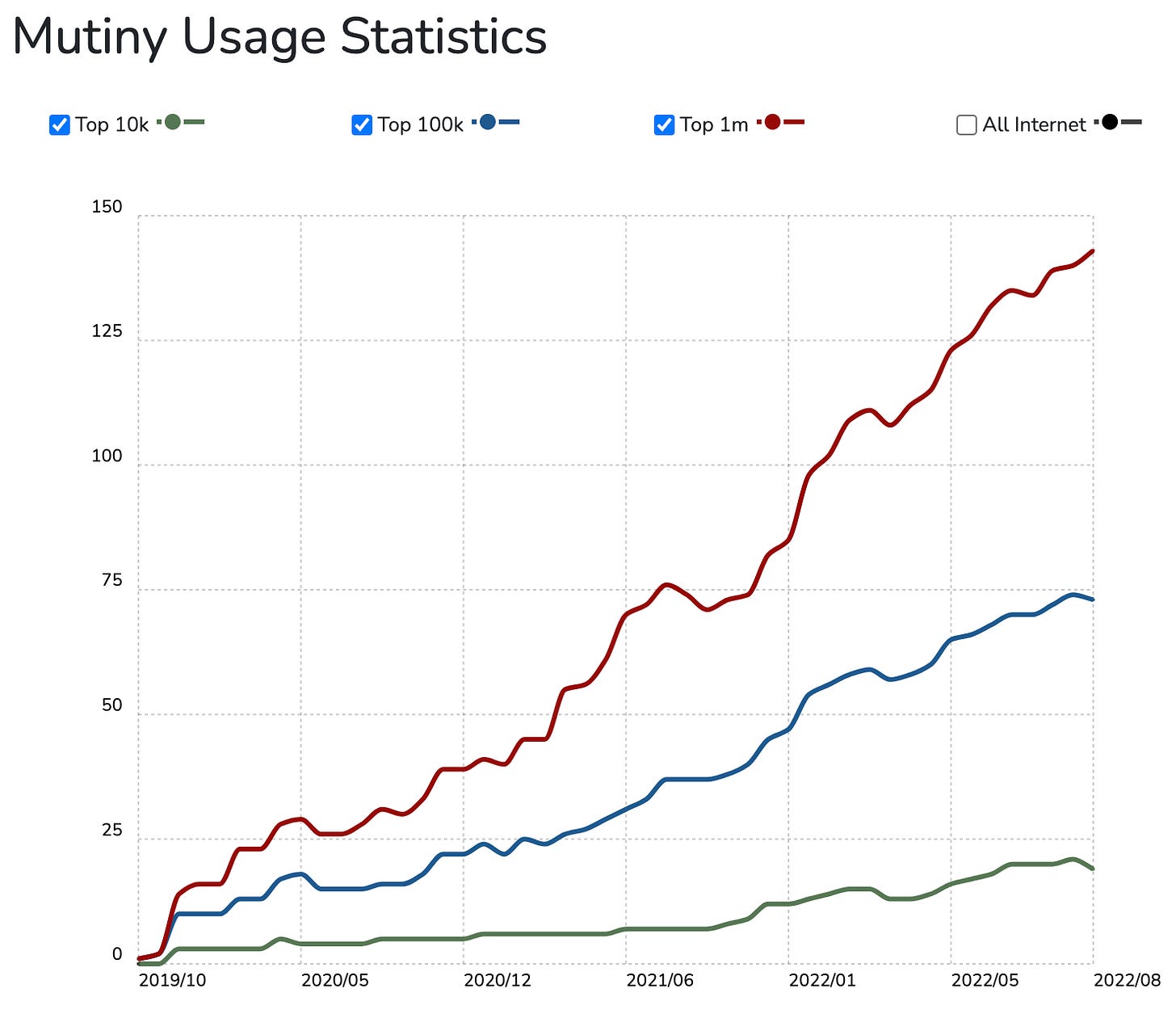
The company was founded in June of 2018 by Jaleh Rezaei and Nikhil Mathew. The two met in 2014 while working at Gusto, where Jaleh led marketing and Nikhil led developer infrastructure. There, they worked together to build Gusto’s growth engineering team, which 100x’ed the company’s revenue over 4 years.
On the grounds of their impressive traction, product, and team, Mutiny raised a 50 million dollar series B in 2022 led by Tiger Global and Insight Partners. They previously raised an 18.5 million dollar Series A led by Sequoia Capital in 2021. Other investors include Y Combinator, Uncork Capital, Cowboy Ventures, and the CMOs of Snowflake, Salesforce, Carta, Gong, Hopin, and AngelList.
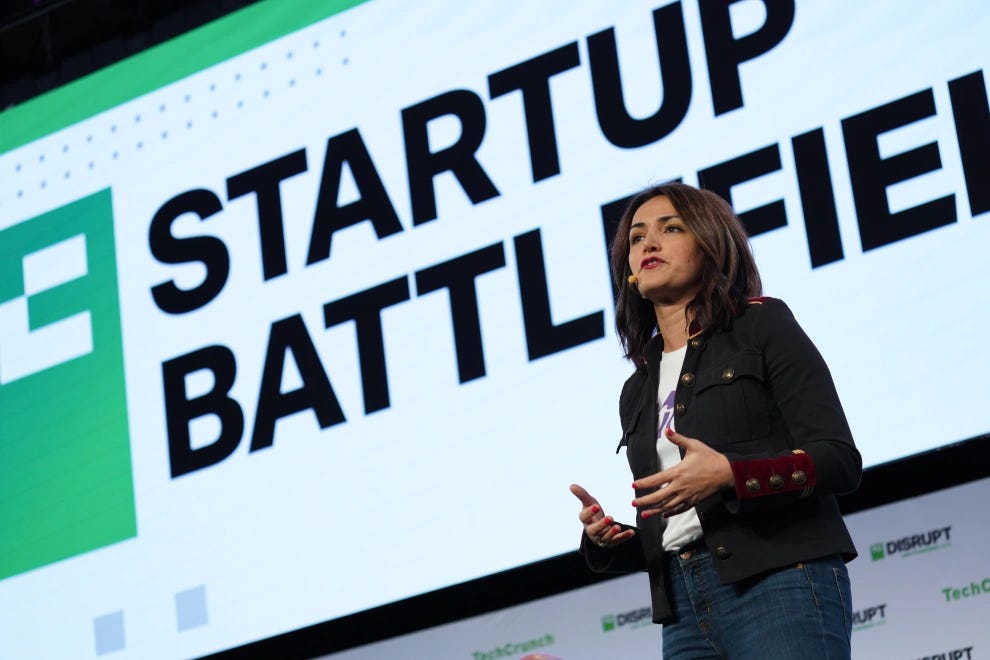
Mutiny has an incredible product with great traction. They’ve got a stacked team with excellent culture. They’ve got a raccoon dressed as a pirate for their logo. Are they, on top of all that, a category-defining business?
We think they have the potential to be.
In this piece, we’ll dig deeper to see why this is the case. We’ll look at how they’re targeting a massive, globally important market. We’ll look at how they’re well-positioned to become a leader in that market. We’ll look at how they stack up against the competition, and why their team is perfect to execute on this opportunity. And we’ll do it all as thoroughly as we can.
Ready? Let’s begin.
Opportunity
We’ll begin our analysis of Mutiny like we do for all of our companies, from a first principle:
In order for a company to become massive, it must become a leader in a massive, growing market.
Many companies with clear product-market fit don’t become truly massive because they don’t meet this condition. Thus, we must establish two things:
Mutiny operates in a massive, growing market.
Mutiny will become a leader in that market.
A Massive, Growing Market
While Mutiny operates in the broader 48.4 billion dollar market around marketing software, they’ve begun by focusing specifically on website personalization. We believe the market for website personalization to be large for the following reasons:
Personalization has never been more important.
Today, 71% of buyers expect companies to deliver personalized interactions, and 76% get frustrated when this doesn’t happen. As a result, 75% of business leaders now consider personalization “table stakes” for digital experiences.
Done right, it can be a huge boost for business: personalization can reduce acquisition costs by as much as 50%, lift revenues by 15 percent, and increase marketing efficiency by 30%. 76% of customers are more likely to purchase from businesses that personalize their experience, 78% are more likely to repurchase from that brand, and 78% are more likely recommend that brand to friends and family. Across US industries, everyone shifting to top-quartile performance in personalization would generate over $1 trillion in value.
As a result, the market for customer experience personalization and optimization tools will grow at a CAGR of 8.7% between 2020 and 2026 to reach 11.6 billion USD per year.
Your website has never been more important.
61% of B2B transactions start on your website, from where customers will complete 57% of their buying process. A poor experience with generic information means a buyer is 88% less likely to re-engage, whereas a good experience with relevant information means a buyer is 2.8 times more likely to experience a high degree of purchase ease and three times more likely to buy a bigger deal. Knowing this, company website optimization was the number one digital marketing investment made by businesses across the country last year, with a full 73.8% of companies participating.
As a result, the market for web content management tools will grow at a CAGR of 15.7% between 2021 and 2026 to reach 14.3 billion USD per year.
Since almost every customer cares about personalization and almost every company cares about their website, it’s reasonable to assume the market for website personalization is massive. We believe it to be a growing market, too, for the following reasons:
Companies are spending more on marketing.
Companies are spending more than ever on marketing and marketing-related expenses:
Global digital ad spend will reach $876.10 billion by 2026, up 68.2 percent from 2021. As companies spend more on ads, they’ll inevitably spend more on the destination of those ads as well.
Global marketing software spend will grow at a CAGR of 14.1% to reach 181.0 billion by 2023. As companies spend more on their marketing departments, they’ll also spend more on website personalization, the fastest growing and most important part of that department.
Companies are relying less on ads.
Even though digital ad spend is improving, conversion rates haven’t followed. With both iOS and Android’s recent privacy and tracking overhauls, ad targeting has become significantly more difficult. As a result, marketers have to compensate by improving efficiency on other parts of the funnel. Website personalization is a critical piece of that.
A Leader in the Market
Mutiny isn’t the only company helping businesses personalize their websites. There are a number of other companies offering their own solutions to the problem. Even so, we believe Mutiny will end up as a market leader for the following reasons:
Mutiny operates with the best product.
Mutiny operates with the best distribution.
Mutiny operates with the best team.
The Best Product
When Mutiny was founded, a lot of the tools needed to personalize websites already existed. There were already a good number of point solutions helping customers to collect data from their sites, train models on that data, run AB tests on different personalization strategies, and implement those strategies in real-time.
What companies were missing, however, was the technical talent and marketing know-how needed to stitch everything together. Most companies didn’t have the growth engineering resources to actually integrate and manage what remained rather technical products.
So more than just helping companies personalize their websites, Mutiny was started with the goal of giving every company the power of their own growth engineering team. The difference in focus is subtle, but it’s made their product way easier to use than anything else on the market. Concretely, Mutiny’s integrated approach reduces both engineering and marketing overhead:
Less Engineering Overhead
Many companies don’t have experienced engineers they can rely on to set up and modify a data/analytics collector, a machine learning agent to profile users, an AI to generate new copy, an AB testing system for different designs, and a toolkit to edit your website in real time. Mutiny’s end-to-end system solves this problem by tying everything together for you.
Under the hood, Mutiny collects visitor data for you, trains a model on that data for you, profiles new visitors with those models for you, generates new personalizations for you, updates your site for you, and tracks conversion against an automatic control group for you, all in one massive loop that gets stronger with time. At any point, marketers can step in and implement their own suggestions for text or image personalizations using a point and click editor.
The result? A platform that can be deployed with just a few lines of Javascript and managed via an intuitive visual editor. No engineers or data scientists necessary.
Less Marketing Overhead
Even with the proper technology, many companies don’t have experienced marketers they can rely on to create and test personalized content: 72% of companies actually view marketing talent as more essential and in-need than technology. Mutiny’s recommendation system uniquely solves this problem.
Once deployed, Mutiny users can leverage GPT-3 recommendations to automate the content ideation and creation process. In addition, their system allows users to see what personalization taglines, copy, and tactics other companies have used, what their corresponding conversion rates were, and which approaches worked best for the specific audiences you’re trying to target. With this, smaller companies are able to leverage the learnings of larger ones for their markets, closing the marketing skills gap. As proof, marketers who use Mutiny’s recommendations launch 143% more tests and see 88% more conversions on their site.
This approach has the added benefit of building a loose network effect. As the number of Mutiny customers and their aggregate audience grows, the value of joining as a new customer grows as well.
Powering all this are some seriously cutting-edge technologies. Technical highlights include their use of GPT-3 to generate custom text, their reinforcement learning algorithms trained on 150 million data points, and a tracking system so good it’s spooky. The first time we visited the Mutiny site (on a fresh incognito window, without being signed in), we were greeted with this:
The Best Distribution
It makes sense that a marketing company founded by an experienced growth marketer and an experienced growth engineer would have the best distribution out of all the companies we’ve covered so far. Outside of traditional top-down sales, Mutiny has built a number of unique tools to help them win on distribution. Three initiatives we found particularly admirable include:
A product demo that lets you see how Mutiny would look on your own site within 60 seconds. It allows you to directly experience their suggestions and editing experience. Check it out here.
A collection of 30+ playbooks profiling specific strategies different companies used to drive conversion and growth. They’ve already racked up a couple million views between them. Check them out here.
A vetted Slack community of ambitious, experienced B2B SaaS marketers who help each other with career-related questions and growth. Mutiny runs the community and regularly hosts in-person dinners, events, and CMO/marketing leaders as speakers. Check it out here.
Between these three and a few other initiatives, Mutiny has developed a strong community and a reputation as the choice tool for the next generation of great marketers. When combined with their rapid time-to-value, it’s easy to see how they regularly close deals in just a few calls:
The Best Team
How did Mutiny build the best product in the space? They had the best team building it, of course. Specifically, they have a team that knows a lot about sales, marketing, and growth engineering:
Jaleh Rezaei - Co-Founder, CEO
Jaleh previously served as Head of Marketing at Gusto, where she 100x’ed ARR by growing the company from five thousand to fifty thousand customers. Before that, she served as a Director of Product Marketing at VMware. Jaleh holds an MBA from Stanford and a B.S. in Engineering from UC Berkeley.
Nikhil Mathew - Co-Founder, CTO
Nikhil previously served as a Software Engineering Lead at Gusto, where he led the developer infrastructure team. Before that, he co-founded LiveGit, a tool for instant music collaboration. Nikhil holds a B.S. in Computer Science from Boston University.
Kevin Yien - Head of Product
Kevin previously served as Head of Growth at Square. Before that, he was the first hire at Launchpad Central, where he grew their customer base from 1 to over 200 organizations. In addition to being a visiting lecturer at Cornell, Kevin holds an M.Eng in Industrial Engineering from UC Berkeley and a B.S. in Materials Science from the University of Michigan.
Julio Bermudez - CRO
Julio previously served as VP of APAC and LATAM sales at Amplitude. Before that, he was Head of Global Sales at BrowserStack and Director of Enterprise Sales at Optimizely.
Ryan Narod - Head of Marketing
Ryan previously served as Head of Marketing at Radar, where he helped to triple revenue. Before that, he was a Product Marketing Manager at Google and the founder of Wiz Studios, a creative agency focused on product marketing.
Fundamentally, Mutiny’s team is just automating what they did themselves at prior companies. The entire executive team is intimately familiar with growth engineering and its challenges, giving them deep empathy for Mutiny’s customers.
Bonding the team further is a strong culture emphasizing ownership in the company and its direction. Everyone at Mutiny regularly speaks with, interviews, and supports customers. Everyone has access to and regularly reviews company-wide metrics and financials. Everyone contributes to Mutiny’s highly iterative development cycle, from scoping features to shipping product to gathering feedback. Nikhil proudly noted that this culture, by design, has made Mutiny a magnet for “founder-type” employees.
All this has all led to an equally strong sense of community across the company, something which Jaleh says is reflected in their quarterly off-sites. Every three months, the company rents a giant AirBnB somewhere new (most recently in Salt Lake City, Chicago, and Hawaii) before flying the whole team out to relax and strategize. We’re told that it’s company tradition for everyone to cook dinner and play games together after work. We’re also told that the company once rented 50 laser guns and turned their entire house into a laster tag arena. Nice.
We’d like to emphasize that Mutiny’s culture is incredibly strong for a fully-remote company. It’s really hard to keep energy high when people aren’t together in person; that they’ve pulled it off nonetheless is a testament to the company’s momentum, hiring practices, and organizational design. You can see everyone’s high morale and ambition for yourself on the company’s Glassdoor profile, which we stalked so you don’t have to :)
Competitive Landscape
We’ve spent some time analyzing Mutiny’s unique strengths as a product and company. Now, let’s look at how they compare against everyone else in the website personalization space.
Point Solutions
In contrast to Mutiny’s integrated approach, point solutions support specific parts of the personalization pipeline. Popular categories include:
Data Collection (Segment, Google Analytics)
A/B Testing (Optimizely, VWO)
Landing Page Design (Unbounce, Leadpages)
While all these products help with the personalization process, none of them solve the problem on their own. A data collection company might provide you with analytics, but it’ll still be on you to generate new designs, test those designs, and program when those designs should be shown. An A/B testing company might give you a framework to run tests, but it’ll still be on you to design those tests, analyze those tests, and personalize on a case-by-case basis.
The time, energy, and custom code this requires is too much for most companies, which is why integrated solutions are more attractive.
Integrated Solutions
As implied above, integrated solutions offer in one simple package what used to be five separate products and tons of custom code. We think that Mutiny has the best product in this category, but we’ve included the other major players for your consideration below:
Oracle ATG Web Commerce helps companies automate and personalize their online buying experiences. As an extension to the Oracle Commerce e-commerce platform, it wasn’t designed to be a standalone product. It doesn’t look particularly user-friendly as a result:
Adobe Target helps companies tailor and personalize their websites around individual visitors. Like Oracle’s offering, it looks rather difficult to implement and is more of an extension for existing Adobe customers. Their adoption has been on a steady decline:
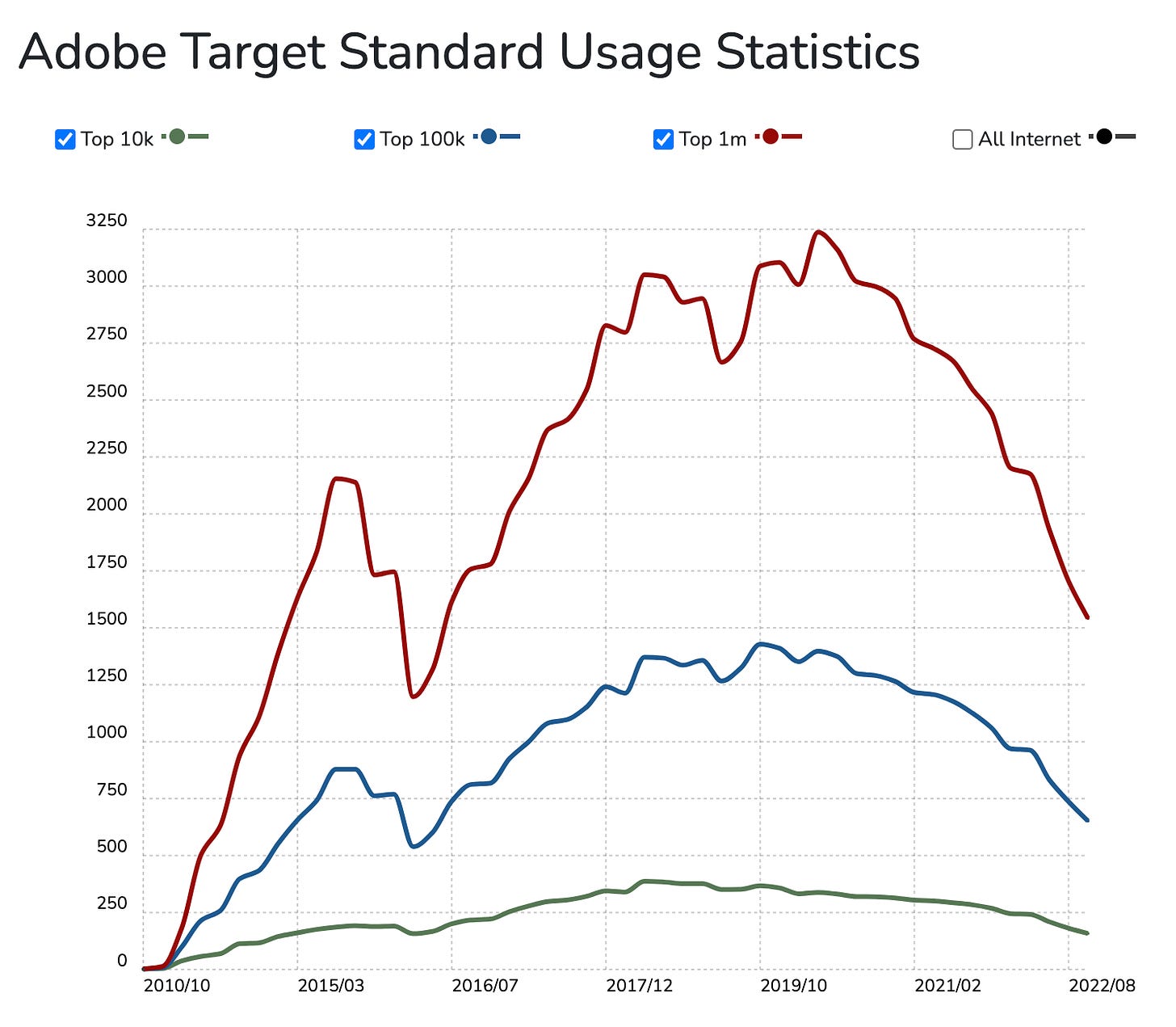
Adobe Target usage across top sites. Source.
Intellimize is a Series B-stage startup that helps customers personalize their websites. They have a cleaner product than Adobe and Oracle, but they lack important features like cross-company learnings and AI-powered suggestions.
Personalizely is a bootstrapped Russian startup that helps customers personalize their websites. Having only five employees, their product is significantly less mature than the others listed.
The Long Term
While Mutiny’s focus today is website personalization for B2B SaaS businesses, their ultimate mission is to give every company the power of their own growth engineering team. To achieve this, they’ll have to expand:
Product-wise, Mutiny can grow beyond websites to support the many other things growth engineers usually touch. Helping companies optimize their email communications, product suggestions, and digital advertisements all make sense in the future.
Market-wise, Mutiny can grow beyond B2B SaaS businesses to support all companies with conversion. Helping e-commerce and B2C businesses with website personalization all make sense in the future.
Every business desires the conversion lift that personalization brings, but few have the growth engineering resources to make it happen. As a result, it’s not an overstatement to say that Mutiny’s total addressable market truly limitless. If Mutiny executes correctly, there’s no limit on how far they can go.
As they expand, they’ll grow stronger due to the data network effects they enjoy. Since their product allows users to see what worked best for other companies on different target audiences, their product becomes more valuable as they aggregate more examples, experiments, and results from across their userbase. If you’re a startup and you want to see exactly how Ramp, Notion, or Brex optimized their conversion, you’ll have to become a Mutiny customer like them.
Conclusion
The Adpocalypse is upon us, but it’s only happening because no one understands conversion. If advertisers were to spend less money generating new clicks and more on converting old ones, we guarantee that the internet would be a happier place for everyone involved. It’s time for a revolution in marketing. Join the Mutiny: https://www.mutinyhq.com/careers.
Thanks for reading! In case you missed our previous pieces, check them out here:
And to make sure you don’t miss any future ones, be sure to subscribe here:
Finally, if you’re a founder or investor with a company you think we should cover please reach out to us at ericzhou@stanford.edu and uhanif@stanford.edu - we’d love to hear about it :)





